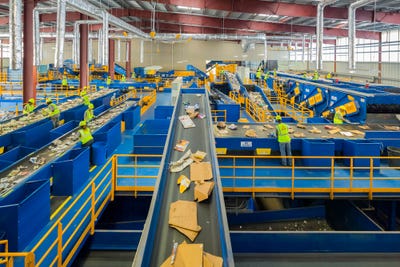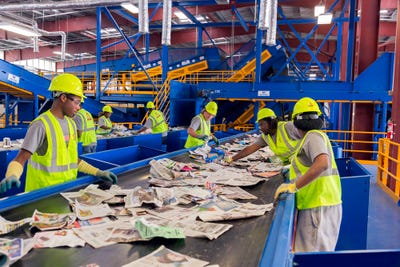In Sort Order
Improving single-stream recycling technologies are changing the way we think about trash.
July 6, 2012
Michael Fickes, Contributing Writer
Republic Services Inc. recently opened a new $6.5 million single-stream material recycling facility (MRF) in northwest Jacksonville, Fla. The plant’s advanced technology illustrates the latest improvements in separating materials with greater efficiency and less contamination, while also enabling new materials to be extracted.
For households and businesses, continuously improving single-stream recycling technologies and smarter processing line configurations are making it possible to drop considerably more material into the recycling bin and less into the trash. Republic Services executives describe this progressive change as the leading edge of a paradigm shift that will eventually enable households and businesses to focus on recycling first and trash second.
What are these new technologies? They’re the same sorting technologies MRFs have long contained — screens, glass cleaning stations, optical scanners, eddy currents and bunkers — but better.
Strengthening Screens
Improved technology allows for cleaner sorting and less contamination, which yields commodities that bring premiums from manufacturers and re-processors.
“Screen and optical sorting technologies have advanced a lot in the last five years,” says Pete Keller, vice president, recycling and customer solutions with Republic Services. “Eddy currents today are more powerful than ever.”
 Improved metallurgy has strengthened the metal shafts used to construct screens and enabled manufacturers to widen screens from 96 inches to 144 inches, continues Keller. These wider screens are capable of processing more material.
Improved metallurgy has strengthened the metal shafts used to construct screens and enabled manufacturers to widen screens from 96 inches to 144 inches, continues Keller. These wider screens are capable of processing more material.
In addition, engineers have discarded round screen shafts in favor of square shafts measuring 4.25 inches on each side. “The square shape allows for faster, easier cleaning and removal of materials wrapped around the shaft,” says Brent Batliner, area business development and recycling manager in Republic Services’ St. Louis offices. “The 17-inch circumference is important too. Why? Because most plastic grocery bags are 16 inches tall and will not wrap around the shaft.”
Plastic grocery bags have plagued the efficiency of single-stream recycling for years. When they become wrapped around the shafts, they eventually require the line to be shut down for maintenance. So bigger, square shafts keep the line moving and improve productivity.
The discs that the shafts turn have improved as well. “The rubber is stronger and longer-lived,” Batliner says. “In addition, we can add or remove disks to the shaft to widen or tighten the spacing. We used to have to install new shafts to do this.”
Eagle-Eyed Optics
Optical sorting technology has become faster and more precise in recent years. Now a line can have a number of programmable units. The first might identify polyethylene terephthalate (PET, or plastic number one) and blow it off the line into the appropriate bunker or conveyor. The second unit would sort high-density polyethylene (HDPE, or plastic number two), while the third would capture plastics numbers three through seven. For now at least, plastics three through seven are baled together and sent to a secondary processor.
“The scanners have higher resolutions,” Keller says. “They can identify smaller pieces like pill bottles where before they were limited to containers the size of a soda bottle. The more advanced systems also have more air nozzles, which increases accuracy. Today’s units are fast. They can sort many more tons per hour than people with 96 to 97 percent accuracy.”
Eddy Currents Get a Charge
Eddy current technology conveys aluminum containers through a field of electrons, which attach themselves to the cans and give them a negative electrical charge. The conveyor then carries the cans across a negatively charged magnet, which repels the negatively charged aluminum container up and into a bunker.
“Today, eddy current technology can induce stronger charges in the aluminum and throw the containers farther,” Keller says. “Throwing containers longer distances reduces cross contamination.
“For instance, suppose a piece of paper is lying on top of a can. If you throw the can eight inches, the paper may go with it. If you throw it 24 inches, the paper will fall off, and you will get much cleaner aluminum.”
Better Sorts in Jacksonville
The new Republic Services MRF in Jacksonville spans 70,000 square feet and can process more than 30 tons per hour (tph) of material by simultaneously loading single-stream and dual-stream recyclables. All told, the facility can process approximately 65,000 tons of recyclables per year by combining improved technologies and properly sized screening elements.
The line accepts commercial and residential single-stream recycling material at a rate of 22 tph.
Commercial single-stream materials are typically 45 to 50 percent cardboard. A residential single-stream mix is 45 to 47 percent old newspaper pulp (ONP) with some cardboard.
After employees remove plastic bags, large objects and non-recyclables on a pre-sort line, a triple deck old corrugated container (OCC) screen begins the automated sorting process.
As large pieces of cardboard ride up to the top of the first level, containers and paper ride on top of the cardboard. The screen is constructed so that the large pieces of cardboard will fall through to the next level, flipping over and dumping the smaller materials onto appropriate conveyors.
 The materials separated from OCC feed onto a small bypass screen. Items four inches and larger remain on the screen. Small containers fall through. Large containers stay on top with the smaller OCC, newspaper and other fiber and move to the ONP screen.
The materials separated from OCC feed onto a small bypass screen. Items four inches and larger remain on the screen. Small containers fall through. Large containers stay on top with the smaller OCC, newspaper and other fiber and move to the ONP screen.
The Jacksonville plant has a double-deck ONP screen. “Often, we use two ONP screens in series,” Keller says. “But in this design, we’ve stacked two. Like the OCC screen, news screens have large openings. The larger paper stays on top. Smaller pieces and containers fall through.”
At this point, something unusual happens. Not all of the Jacksonville region’s communities have switched to single stream. Some continue to separate fiber and containers. “Instead of presenting the rigid fraction [containers] of the dual-stream materials to the fiber sorting line, we send them directly to the container line,” Keller says.
This conveyor can push eight tph into the mix, raising the total processing capacity to 22 tph of residential and commercial single stream plus eight tph of dual-stream containers.
Another conveyer dumps the containers and smaller fractions of paper onto a glass breaker or debris roll screen with small openings. The glass containers break into small pieces that fall through the screen.
Some of the glass cullet snags pieces of paper, while other smaller debris, such as bottle caps, also fall through with the glass. Later, the cullet goes through a wind tunnel with negative and positive cyclones that vacuum lighter fiber and other fractions off of the heavier glass.
The conveyors carrying the remaining containers head for the optical sorting stations where high intensity halogen lamps illuminate the plastic containers. Each variety of resin refracts light in different ways. Scanners measure the differences, identify plastics number one, two and three through seven and separate them with puffs of air, which is technically described as air classification. While the machines are capable of sorting the latter plastics individually, there is so little of that material in the recycling stream and so little impetus to reprocess it that there’s currently little reason to do so.
After sorting fiber and plastic containers, magnets pull out ferrous-based containers and eddy currents to toss out aluminum containers.
Along the way, as always, quality control employees pick un-separated materials off the conveyors, ensuring that the right recyclables make it to the right conveyors.
Walk This Way
 The separated varieties of fiber and containers fill up “walking floor” bunkers. Moving aluminum slats compose the floors of these bunkers. The slats slowly inch the material in the bunker forward. Then the slats move backwards quickly without moving the material. In this way, a walking floor pushes the material out through doors at the end of the bunker and onto a conveyor that carries the materials to one of two balers positioned side by side. The conveyor runs in between the balers, where it runs into a second conveyor set at a 90-degree angle. The second conveyor runs in both directions. It fills one baler, switches directions and fills the other.
The separated varieties of fiber and containers fill up “walking floor” bunkers. Moving aluminum slats compose the floors of these bunkers. The slats slowly inch the material in the bunker forward. Then the slats move backwards quickly without moving the material. In this way, a walking floor pushes the material out through doors at the end of the bunker and onto a conveyor that carries the materials to one of two balers positioned side by side. The conveyor runs in between the balers, where it runs into a second conveyor set at a 90-degree angle. The second conveyor runs in both directions. It fills one baler, switches directions and fills the other.
Trucks carry the bales to manufacturers or secondary processors, depending on the material.
Every generation of single-stream recycling MRFs has improved upon its predecessors with ever more refined technologies that work more efficiently, produce cleaner, less contaminated commodities and find more ways to extract new commodities from the trash. Republic Services’ Jacksonville MRF is the latest example.
Mike Fickes is a Westminster, Md.-based contributing writer.
SIDEBAR: Another Piece of Trash Moves to the Recycling Bin
Republic Services recently announced a $19 million plan to upgrade two recycling centers in the St. Louis region. Those centers will draw on the technologies applied in Jacksonville, while adding new capabilities.
For instance, the optical sorting station will have a sensor capable of separating aseptic food containers, commonly known as cartons, which sandwich a thin layer of aluminum between two layers of paper. (See “Thinking Inside the Box” for more on carton recycling.)
These packages do not contain enough aluminum to accept a charge on the eddy current line. So by and large aseptic containers have been treated as residue sent to landfills.
In an unusual partnership, Republic Services and the Carton Council have teamed up to change that. “The Carton Council came to us and said they would buy the technology if we installed it in our optical line,” says Brent Batliner, area business development and recycling manager in Republic Services’ St. Louis offices. “This is exciting. Aseptic packaging has been a no-no for years in the recycling world.”
Soon, St. Louis households and businesses will be able to pull aseptic containers out of the trash and drop them in the recycling bin. —MF
You May Also Like


.png?width=300&auto=webp&quality=80&disable=upscale)